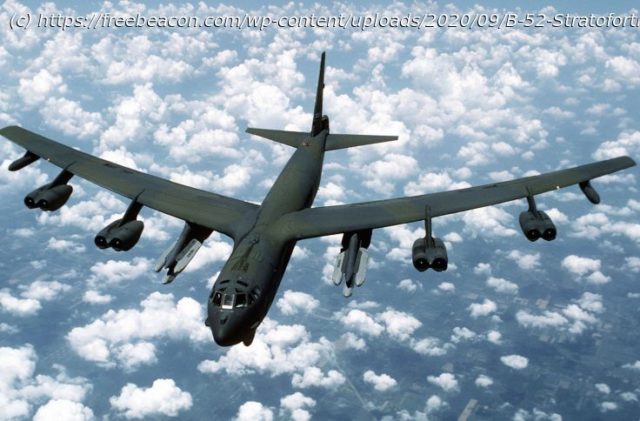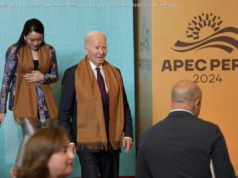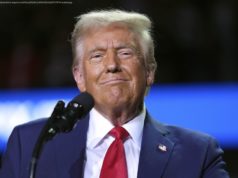By David Lague
HONG KONG (Reuters) – On July 21, two U.S Air Force B-1B bombers took off from Guam and headed west …
By David Lague HONG KONG (Reuters) – On July 21, two U. S Air Force B-1B bombers took off from Guam and headed west over the Pacific Ocean to the hotly contested South China Sea. The sleek jets made a low-level pass over the aircraft carrier USS Ronald Reagan and its escorting fleet, which was exercising nearby in the Philippines Sea, according to images released by the U. S. military. The operation was part of the Trump administration’s intensifying challenge to China’s ruling Communist Party and its sweeping territorial claims over one of the world’s most important strategic waterways. While senior Trump officials launch diplomatic and rhetorical broadsides at Beijing, the U. S. Defense Department is turning to the firepower of its heavily armed, long-range bombers as it seeks to counter Beijing’s bid to control the seas off the Chinese coast. Since late January, American B-1B and B-52 bombers, usually operating in pairs, have flown about 20 missions over key waterways, including the South China Sea, the East China Sea and the Sea of Japan, according to accounts of these flights from U. S. Air Force statements and official social media posts. These missions, military analysts say, are designed to send a crystal-clear signal: The United States can threaten China’s fleet and Chinese land targets at any time, from distant bases, without having to move America’s aircraft carriers and other expensive surface warships within range of Beijing’s massive arsenal of missiles. In this response to the growing power of China’s military, the Pentagon has combined some of its oldest weapons with some of its newest: Cold War-era bombers and cutting-edge, stealthy missiles. The supersonic B1-B first entered service in 1986; the newest plane in the B-52 fleet was built during the Kennedy administration. But these workhorses can carry a huge payload of precision weapons. A B-1B can carry 24 of the U. S. military’s stealthy new Long Range Anti-Ship Missiles, which entered service in 2018 and can strike targets at ranges of up to 600 kilometers, according to U. S. and other Western officials. « A single B-1 can deliver the same ordnance payload as an entire carrier battle group in a day, » said David Deptula, dean of the Washington-based Mitchell Institute for Aerospace Studies and a retired U. S. Air Force Lieutenant General. And, in a crisis, he added, bombers can be rapidly deployed. « Depending on where they are, ships can take weeks to get in place, » said Deptula. « But by using bombers, they can respond in a matter of hours, » he adds, noting that the U. S. object is to deter war. « Nobody wants to engage in conflict with China. » Chinese and western military strategists warn that a conflict between the two nuclear-armed powers could be difficult to contain. In a clash with China, this fast response from the bomber force could be vital while the U. S. and its allies rush naval reinforcements to the Pacific to bolster the vastly outnumbered U. S. naval fleet stationed in the region, according to current and former U. S. and other Western military officers. A spokeswoman for Pacific Air Forces, Captain Veronica Perez, said the U. S. Air Force had increased its publicity about its bomber missions to assure allies and partners of Washington’s commitment to global security, regional stability and a free and open Indo-Pacific. « Though the frequency and scope of our operations vary based on the current operating environment, the U. S. has a persistent military presence and routinely operates throughout the Indo-Pacific, » she said. China’s defense ministry did not respond to questions from Reuters. LOWEST POINT While the bomber missions continue, relations between Washington and Beijing have reached their lowest point since the 1989 Tiananmen crackdown. In a show of force, Chinese fighter jets crossed the mid-line of the Taiwan Strait while U. S. Secretary for Health, Alex Azar, was visiting Taipei on Aug.10 to congratulate the government of President Tsai Ing-wen on its successful containment of the COVID-19 virus. Azar was the most senior American official to visit Taiwan in four decades. Taiwan’s missile radars tracked the Chinese fighters in only the third such incursion across the median line since 2016, the Taiwanese government said. Beijing condemned the visit. It regards the island as a province of China and hasn’t ruled out the use of force to bring it under Communist Party control. In a series of speeches ahead of Azar’s visit, top Trump officials had hammered China on multiple fronts, including its military build-up, territorial ambitions, domestic political repression, intellectual property theft, espionage, trade practices and its failure to alert the world to the danger of COVID-19. In one of the most harshly worded attacks on China from an American official in decades, U. S. Secretary of State Mike Pompeo said on July 23 that China’s military, the People’s Liberation Army (PLA), was not a normal fighting force. « Its purpose is to uphold the absolute rule of the Chinese Communist Party elites and expand a Chinese empire, not protect the Chinese people, » he said. « And so our Department of Defense has ramped up its efforts, freedom of navigation operations out and throughout the East and South China Seas and in the Taiwan Strait as well. » In July, Pompeo declared most of Beijing’s claims of sovereignty over the South China Sea illegal. With the combination of bombers and long-range missiles, the United States is trying to turn the tables on the PLA. Over more than two decades, China has assembled a force of ground, sea and air-launched missiles that would make it deadly for warships of the U. S. Navy and its allies to approach the Chinese coast in a conflict. This Chinese strategy is specifically tailored to threaten U.






